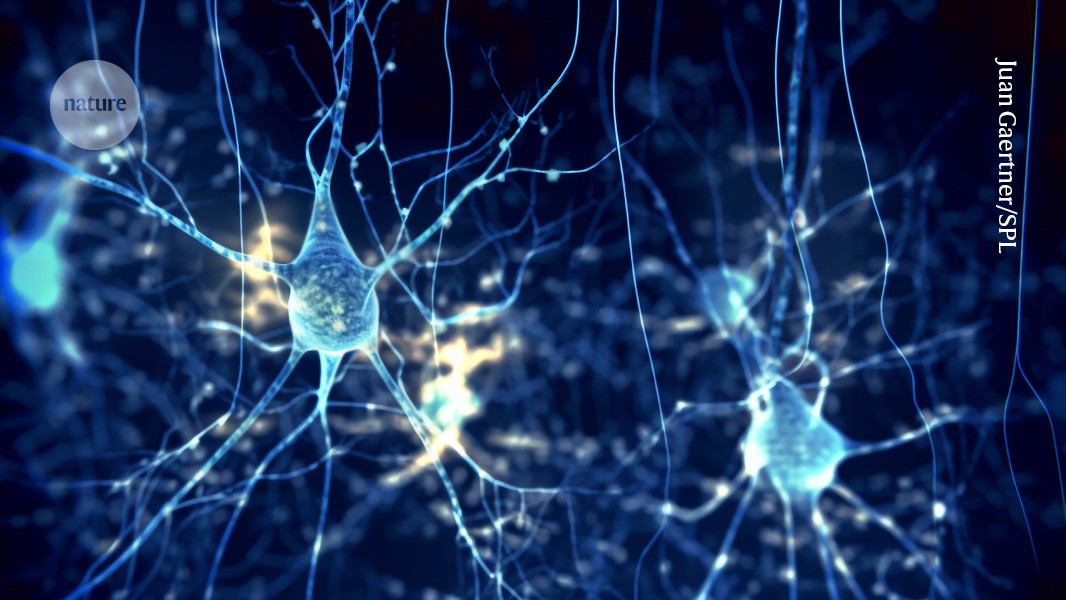Stress can dull our capacity for joy: mouse brain patterns hint at why

Scientists pinpoint brain circuits linked to either resilience or vulnerability to adversity, which affect a stressed animal’s pursuit of pleasure

Communication between neurons (illustration) in two separate brain regions is patchy in mice that are susceptible to severe stress. Credit: Juan Gaertner/Science Photo Library
Joylessness triggered by stress creates a distinct brain signature, according to research in mice1. The study also reveals one brain pattern that seems to confer resilience to stress ― and another that makes stressed animals less likely to feel pleasure, a core symptom of depression.
These findings, published today in Nature, offer clues as to how the brain gives rise to anhedonia, a resistance to enjoyment and pleasure. The results also provide a new avenue for treating the condition ― if the findings are validated in humans.
“Their approach in this study is spot on,” says Conor Liston, a neuroscientist at Weill Cornell Medicine in New York City, who was not involved in the work. The experiments fill “a big gap”, he says. “Anhedonia is something we don’t understand very well.”
A distressing symptom
More than 70% of people with severe depression experience anhedonia, which is also common in those with schizophrenia, Parkinson’s disease and other neurological and psychiatric conditions.
The symptom is notoriously difficult to treat, even in those taking medication, Liston says. “Anhedonia is something that patients care about the most, and feel like it’s least addressed by current treatments,” he says.
To understand how the brain gives rise to anhedonia, Mazen Kheirbek, a systems neuroscientist at the University of California, San Francisco, and his colleagues studied mice that had been placed under stress by exposure to larger, more aggressive mice.
Typically, mice have a sweet tooth and prefer sugar water over plain water if given the option. But some stressed mice instead preferred plain water ― which Kheirbek and his colleagues interpreted as a rodent version of anhedonia. Other mice subjected to the same stress preferred the sugar water. The authors labelled these animals ‘resilient’.
The researchers then monitored neurons in the amygdala and hippocampus, two brain regions that are important for processing emotions, in mice that were deciding between sugar water and plain water after earlier exposure to stress.
Building a resilient brain
Resilient mice had robust communication between the amygdala and hippocampus, whereas in animals susceptible to anhedonia, communication between the two brain areas was fragmented.
To improve the disjointed communication in susceptible mice, the researchers injected the rodents with compounds that caused neurons in the target areas to fire more frequently. These animals opted for sugar water more often than they had before the injections, and their brain activity was more similar to that of the resilient mice, the authors found.
“It’s very easy to stimulate a part of the brain and break it, but here a very mild stimulation slightly elevates activity and enhances a resiliency signature,” Kheirbek says.
Reward-seeking behaviour
Rose Bagot, a neuroscientist at McGill University in Montreal, Canada, who wasn’t involved with the study, says that the data make clear that there is a difference in how resilient and susceptible mice process information about rewards. “People often think simplistically of anhedonia as the inability to experience pleasure, but this study shows that it’s more about changes in the ability to use information about reward to guide behaviour,” she says.
Understanding these neuronal firing patterns has also yielded a way to discern which animals had a history of stress. In resting mice, spontaneous activity in a specific part of the amygdala was a signature of past trauma. The authors say that this could serve as a biomarker of stress that would be more reliable than behaviour, such as decreased appetite, alone.
Answers to whether these findings apply to people might not be far off: therapeutic electrodes implanted in the brains of people with epilepsy or treatment-resistant depression have also yielded data on brain activity. Liston says that, after reading this study, if he had data from people with these conditions, he would want to see whether they validate the authors’ findings.
Researchers homed in on the amygdala and hippocampus connection in this paper, but Kheirbek says he plans to look at other relevant brain regions, such as the prefrontal cortex, which plays a key part in regulating emotions. Bagot adds that, to model human behaviour, it will be important to use a decision-making task in animals that is more complicated than choosing between types of water.
doi: https://doi.org/10.1038/d41586-024-03958-2
This story originally appeared on: Nature - Author:Max Kozlov

















